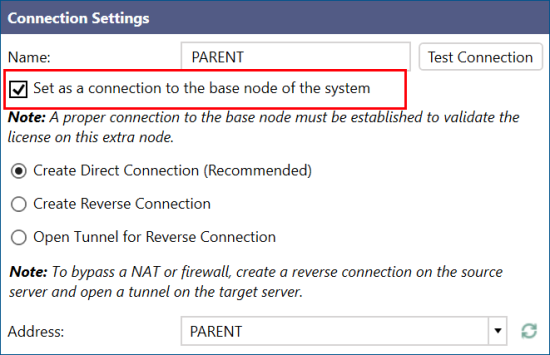Licensing an Additional Node
The process of licensing an additional node is the same as licensing the base node of a system. You should first perform the steps in Activating a New License for the additional node.
GENESIS System
Base nodes and additional nodes can be configured together in what is referred to as a single system. To work together as a system, the nodes must follow a few criteria:
-
Base nodes and additional nodes communicate with each other to confirm their license status.
-
The typical update rate for license status in a system is 5 minutes, and base nodes expect to receive updates at least every 30 minutes.
-
A base node will reject the connection of an additional node if it is not of the same system (this is defined within the license programmed to the nodes).
-
Duplicate node license numbers in a system are identified as a license violation.
After activating the license for an additional node, you need to connect it to the base node.
To connect an additional node to the base node:
- Open Workbench and in Project Explorer, expand your project > Servers and Redundancy > Unified Redundancy.
- Add a connection to the parent machine.
-
Select Set as a connection to the base node of the system.

- Within five minutes, the node will try to connect to the parent and validate the license. The node will periodically check the connectivity with the parent and ensure that the license is always validated.
Monitoring the Status of Nodes in a System with License Monitor
The License Monitor has a Nodes tab that can be used to monitor the status of nodes in a system. When viewed from the base node, all nodes in the system are displayed, when viewed from an additional node, only that node and the base node are displayed. This information can be used to monitor the connectivity of the system and integrity of the license communication.
Information from the Base Node License Monitor
The base node shows the list of all nodes in the system (including itself). Each node shows the node ID, hostname, IP address, status, and situationally, a warning message. The hostname and IP address of the base node are not displayed.
The status can be one of the following:
- Local (the local base node we are currently on)
- Connected
- Disconnected
- Duplicate detected (warning)

Information from an Additional Node License Monitor
An additional node shows itself and the status of the connection to the base node. The potential status of the base node can be one of the following:
- Missing configuration (warning): If the connection to the base node has not been configured yet.
- Pending: After the base node connection configuration has been updated, but the base node has not been contacted yet.
- Connected: Everything is all right.
- Connection failed (warning): Happens, for example, if the base node connection is pointing to a nonexisting FrameWorX™ server or if the base node is offline or unreachable.
- Misconfiguration (warning): Happens, for example, if the base node connection is pointing to an additional node instead of the base node or to a node that does not belong to the same system of nodes.
- Duplicate detected (warning): The base node sends a warning that a different node with the same license is connected to it.
